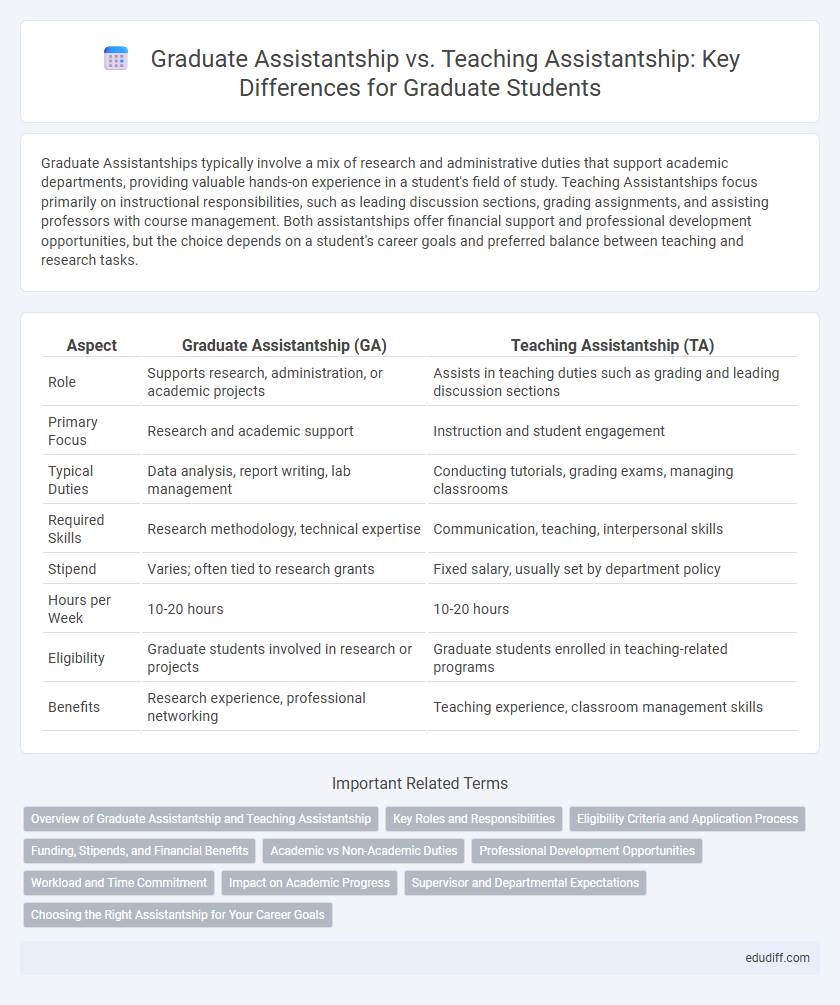Graduate Assistantships typically involve a mix of research and administrative duties that support academic departments, providing valuable hands-on experience in a student's field of study. Teaching Assistantships focus primarily on instructional responsibilities, such as leading discussion sections, grading assignments, and assisting professors with course management. Both assistantships offer financial support and professional development opportunities, but the choice depends on a student's career goals and preferred balance between teaching and research tasks.
Table of Comparison
| Aspect | Graduate Assistantship (GA) | Teaching Assistantship (TA) |
|---|---|---|
| Role | Supports research, administration, or academic projects | Assists in teaching duties such as grading and leading discussion sections |
| Primary Focus | Research and academic support | Instruction and student engagement |
| Typical Duties | Data analysis, report writing, lab management | Conducting tutorials, grading exams, managing classrooms |
| Required Skills | Research methodology, technical expertise | Communication, teaching, interpersonal skills |
| Stipend | Varies; often tied to research grants | Fixed salary, usually set by department policy |
| Hours per Week | 10-20 hours | 10-20 hours |
| Eligibility | Graduate students involved in research or projects | Graduate students enrolled in teaching-related programs |
| Benefits | Research experience, professional networking | Teaching experience, classroom management skills |
Overview of Graduate Assistantship and Teaching Assistantship
Graduate Assistantship (GA) encompasses a broad range of roles including research, administrative, and teaching responsibilities, providing financial support and professional development opportunities for graduate students. Teaching Assistantship (TA) specifically involves assisting faculty with instructional duties such as leading discussion sections, grading assignments, and conducting tutorials. Both assistantships offer stipends and tuition waivers but differ primarily in focus, with GA roles being more diverse and TA roles centering around educational support.
Key Roles and Responsibilities
Graduate Assistantships primarily involve supporting faculty research projects, managing administrative tasks, and assisting with academic programs, enhancing both practical experience and professional development. Teaching Assistantships center on facilitating classroom instruction, grading assignments, leading discussion sections, and providing student support, which develops pedagogical skills and subject matter expertise. Both roles require strong communication, time management, and subject knowledge, but Teaching Assistantships emphasize direct interaction with students while Graduate Assistantships focus more on research and administrative responsibilities.
Eligibility Criteria and Application Process
Graduate assistantship eligibility typically requires enrollment in a graduate program with a minimum GPA, proof of relevant skills, and often department recommendation, while teaching assistantship eligibility demands strong academic performance in specific subject areas, prior teaching experience, and communication skills. The application process for graduate assistantships usually involves submitting a detailed CV, statement of purpose, and letters of recommendation through the university's graduate office, whereas teaching assistantship applications often require additional interviews or teaching demonstrations to assess instructional capability. Both assistantships necessitate timely submission of application materials according to departmental deadlines, with some institutions offering centralized online portals for streamlined processing.
Funding, Stipends, and Financial Benefits
Graduate Assistantships often provide comprehensive funding packages that include tuition waivers, stipends, and health benefits, making them financially advantageous for many students. Teaching Assistantships typically offer stipends combined with partial tuition waivers and opportunities for professional development, but the financial benefits may vary by institution. Comparing the total compensation, Graduate Assistantships tend to have broader financial support, while Teaching Assistantships focus more on teaching experience with moderate funding.
Academic vs Non-Academic Duties
Graduate Assistantships often encompass a blend of academic responsibilities, such as research support and curriculum development, alongside non-academic tasks like administrative coordination. Teaching Assistantships primarily emphasize academic duties, including grading, leading discussion sections, and providing instructional support to faculty. The distinction lies in the balance of scholarly involvement versus logistical and operational functions within the graduate program.
Professional Development Opportunities
Graduate assistantships offer diverse professional development opportunities through research projects, administrative responsibilities, and interdisciplinary collaboration, enhancing skills in project management and academic inquiry. Teaching assistantships primarily focus on pedagogical experience, fostering communication and leadership skills by engaging directly with students and designing instructional materials. Both roles provide valuable career-building experiences, but graduate assistantships tend to offer broader exposure to research and administrative tasks, while teaching assistantships emphasize teaching and curriculum development expertise.
Workload and Time Commitment
Graduate Assistantship typically involves diverse responsibilities such as research, administrative tasks, or project management, requiring around 15-20 hours per week. Teaching Assistantship focuses primarily on instructional duties including grading, leading discussion sections, and supporting professors, often demanding a similar 10-20 hours weekly commitment. Both roles require balancing academic and assistantship duties, with workload intensity often varying by department and specific assignment.
Impact on Academic Progress
Graduate assistantships provide diverse research opportunities that enhance specialized skills and contribute significantly to thesis development, accelerating academic progress. Teaching assistantships improve communication and instructional abilities while offering consistent exposure to course content, which reinforces subject mastery and supports timely degree completion. Both assistantships serve as critical financial and experiential support structures, directly influencing graduate students' academic success and skill acquisition.
Supervisor and Departmental Expectations
Graduate Assistantships often require supervisors to oversee research projects, ensuring alignment with departmental goals and fostering specialized expertise development. Teaching Assistantships mandate supervisors to prioritize instructional support, grading, and facilitating classroom discussions, emphasizing departmental standards for academic delivery. Both roles demand clear communication of responsibilities to meet faculty expectations and promote student success within the department's framework.
Choosing the Right Assistantship for Your Career Goals
Graduate assistantships offer a broad range of responsibilities including research, administrative tasks, and academic support, making them ideal for students aiming to gain comprehensive experience in their field. Teaching assistantships emphasize classroom instruction, grading, and direct interaction with students, benefiting those who plan to pursue careers in academia or education. Selecting the right assistantship depends on aligning these roles with your long-term career goals, skill development needs, and professional interests.
Graduate Assistantship vs Teaching Assistantship Infographic

 edudiff.com
edudiff.com